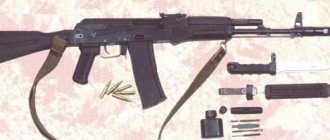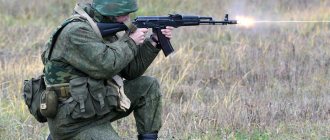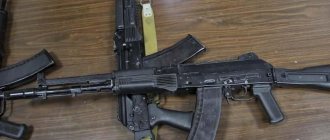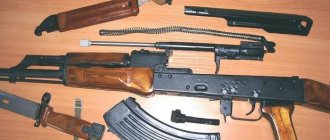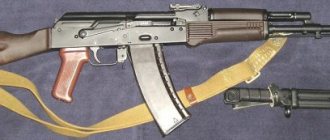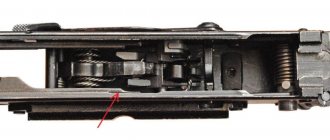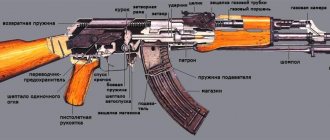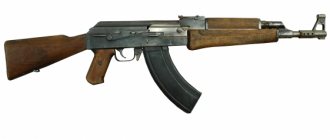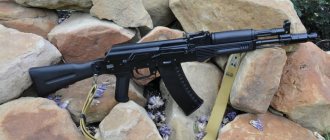Home | Weapons | Assault rifles | Russia / USSR | Kalashnikov assault rifle AKS-74U
Kalashnikov assault rifle AKS-74U Photo (c) KardeN
Kalashnikov AKS-74U assault rifle with the butt folded down Photo (c) KardeN
Kalashnikov AKS-74U assault rifle with a collimator sight, ergonomic pistol grip fire control and front grip
AKS-74U (GRAU Index - 6P26, “5.45-mm folding shortened Kalashnikov assault rifle”) - a shortened modification of the AK-74 automatic carbine, was developed in the late 1970s - early 1980s to arm the crews of combat vehicles and aircraft , gun crews, as well as paratroopers. It is also used in the Ministry of Internal Affairs and security structures due to its small size.
After the end of the Soviet-German war and the transition of the Soviet armed forces to the AK family of small arms, not a single production model of a submachine gun was adopted in the USSR, although the need for this type of weapon was observed quite urgently. Since the AKS and its descendants could not replace the PP due to their size, the creation of a weapon capable of filling this niche began after the adoption of an intermediate small-caliber cartridge of 5.45x39 mm.
In the late 60s and early 70s of the 20th century, a worldwide trend towards the creation of completely new tactical combat firearms by slightly altering existing assault rifles began to noticeably manifest itself. Designers from Belgium, the USA, Great Britain, and Hungary became trendsetters: by significantly shortening the barrel and using a folding stock, they smartly adjusted the weight and size parameters of standard assault rifles closer and closer to those characteristic of the submachine gun class, while maintaining a clear superiority in the power of fire.
The development of a compact model of a standard army weapon was started in the USSR as part of the “Modern” competition, in which eminent gunsmiths from Izhevsk, Kovrov, and Tula were involved.
A fairly simple and cheap small-sized sample was developed in 1975 in its own unique style at the design bureau under the leadership of S.G. Simonova. An experimental version of the gas exhaust AG-043 with a metal sliding shoulder rest was superior in weight (2.1 kg without cartridges) to many submachine guns and was “fed” from a standard plastic 30-round magazine from an AK-74. The AG-043 did not have any special advantages in terms of rate of fire, ballistics or operational reliability; its main captivating advantage remained its obvious compactness (which gave rise to sensational rumors about its “KGB” purpose as a concealed carry weapon - completely folding the butt reduced the length of the weapon more than one and a half times, from 680 to 420 mm).
Tula TsKIB SOO presented several experimental versions of a shortened sample of I.Ya.’s design for state tests on the “Modern” theme in the early 1970s. Stechkina. His TKB-0116 could easily claim the title of the most unusual competitor. Automatic with a short stroke of the barrel, the rotation of which also carried out locking.
The main element of the gas engine was the muzzle, which also served as a flame arrester and compensator. A straight box magazine with 20 rounds of ammunition and a folding shoulder rest gave the weapon a certain charm. Very flattering reviews from testers, primarily in terms of combat accuracy, gave Stechkin’s “Modern” a good chance in fair competition.
Things were easiest in Izhevsk, where they created compact weapons based on the Kalashnikov design. The AKM design, worked out to the smallest detail, and the design of its 5.45 mm successor, coded A-3, eliminated the need to start all over again.
The barrel was shortened to 255 millimeters, the gas chamber and the base of the front sight were moved back (correspondingly reducing the length of the gas piston rod), and a voluminous cylindrical muzzle was introduced to ensure complete combustion of the gunpowder when fired. The sector sight was replaced with a simple L-shaped flip rear sight on the receiver cover, now permanently attached to the weapon and hinged upward when disassembled.
The wire metal stock with a rotating butt plate, like the Stechkin assault rifle, folded upward, reducing the total length of the weapon to 475 mm. In 1973, the first experimental Mini-Kalashnikov was slightly improved.
The trunk was “cut” by another 35 millimeters. The stock was borrowed from AKMS. The design of the gas outlet unit and the muzzle was moderately improved - the machine gun became more beautiful. The greater pressure of powder gases at the muzzle of the barrel urgently required the installation of a reinforced flash suppressor-afterburner. The 1976 prototype had an even shorter barrel (206.5 mm), a tubular shaped shoulder rest folding to the right, and a weight reduced to 2.4 kg. The final version of the small-sized AK was maximally unified with the AKS-74, which had already been adopted by that time.
In the end, the Izhevsk version of the shortened AK ended up in the competition for a new compact assault rifle “due to the high unification of production and operation in relation to the AKS74 assault rifle.” The mechanisms, layout of controls and general structure were similar to the AKS-74, which not only reduced the cost of production and facilitated maintenance and repair, but also simplified the training of personnel.
However, the new compact AK also has some disadvantages. The barrel of the “baby”, shortened by half compared to the original, as one would expect, sharply reduced the initial speed of the bullet to 735 m/s and, hence, the effective firing range (along with the effective one). Therefore, the need for a complex sighting device naturally disappeared.
In 1980, under the brand name AKS-74U (6P26), the assault rifle began to enter the USSR troops.
Initially, the AKS-74U was equipped with a plastic pistol grip, a wooden fore-end and a barrel guard; later, around 1991, the wood was replaced with glass-filled polyamide on the AKS-74U, as well as on other members of the AK-74 family. Plastic parts increased wear resistance and slightly reduced the weight of the machine.
Features of AKS-74U
Differences from AKS-74:
- trunk shortened by 2 times,
- shortened gas piston rod,
- a special muzzle is installed, serving as an expansion chamber and flame arrester,
- the receiver cover is hinged to the receiver in its front part,
- installation of the rear sight at 350 and 500 meters,
- there is no rate of fire retarder,
- The rifling stroke length was reduced from 200 to 160 mm (for better stabilization of the bullet in flight with a short barrel).
From the point of view of all mechanisms, the AKS-74U is completely similar to the AK-74, with the exception of the trigger rotation limiter, installed instead of the tempo retarder.
AK-47
The classic, very first AK-47 adopted for service is difficult to confuse with anything else. Made of iron and wood, without any bells and whistles, it has long become a symbol of reliability and ease of use in any conditions. At the same time, it didn’t take long for the machine gun to become like this: it took Mikhail Kalashnikov several years to bring his creation to fruition.
In 1946, the military leadership of the USSR announced a competition to create an assault rifle chambered for an intermediate (in terms of destructive power - between a pistol and a rifle) cartridge. The new weapon had to be maneuverable, fast-firing, and have sufficient bullet lethality and shooting accuracy. The competition took place in several stages and was extended more than once, since none of the gunsmiths could give the required result. In particular, the commission sent AK-46 models No. 1, No. 2 and No. 3 (with a folding metal stock) for revision.
The improved Kalashnikov assault rifle, which was given the index AK-47, as Sergei Monetchikov writes in the book “The History of the Russian Automatic,” was almost completely redesigned. The best ideas were borrowed from the designs of competitors' weapons, implemented in individual parts and entire assemblies.
The machine gun did not have a classic solid stock. Taking into account the strong receiver, the separate wooden stock and fore-end contributed to holding the weapon during shooting. The design of the receiver was redesigned; it was fundamentally different from the previous ones with a special liner rigidly attached to it, connecting it to the barrel. In particular, a reflector of spent cartridges was attached to the insert.
The reloading handle, made integral with the bolt frame, was moved to the right side. This was demanded by test soldiers; they noted: the left-sided position of the handle interferes with shooting while moving on the move without stopping, touching the stomach. In the same position it is inconvenient to reload the weapon.
The transfer of controls to the right side of the receiver made it possible to create a successful fire switch (from single to automatic), which is also a fuse, made in the form of a single rotating part.
The large mass of the bolt frame and a powerful return spring ensured reliable operation of the mechanisms, including in adverse conditions: dusty, dirty, thickened lubricant. The weapon turned out to be adapted for trouble-free operation in the range of air temperature changes up to 100 degrees Celsius.
The wooden parts of the new weapon - the butt, fore-end and receiver grip, as well as the pistol grip, made from birch blanks - were coated with three layers of varnish, which ensured their sufficient resistance to swelling in damp conditions.
Device
The operation of the AKS-74U automation is based on the use of the energy of powder gases removed from the barrel bore. When fired, part of the powder gases that push the bullet is directed through a hole in the barrel wall into the gas chamber, pressing on the front wall of the gas piston, throwing the piston and bolt frame with the bolt to the rear position. The bolt opens the barrel, removes the cartridge case from the chamber and throws it out. The bolt frame compresses the return spring and cocks the self-timer.
Under the action of the return mechanism, the bolt frame and bolt return to the forward position. The bolt sends a new cartridge into the chamber and locks the barrel. The bolt frame removes the self-timer sear from under the self-timer cocking of the trigger. The trigger is cocked.
The barrel bore is locked by turning the bolt to the right around the longitudinal axis and, as a result, by moving its lugs past the lugs of the receiver.
AKS-74U consists of the following main parts and mechanisms:
- barrel with receiver and receiver cover, with trigger mechanism, sighting device, folding stock and pistol grip;
- flame arrester;
- bolt carrier with gas piston;
- gate;
- return mechanism;
- gas tube with receiver lining;
- forend;
- shop;
- belt.
The AKS-74U kit includes: a case, accessories (a cleaning rod, a cleaning rod, a brush, a screwdriver, a drift, an oil can, four clips and an adapter), three spare magazines and a bag for carrying magazines and accessories. The AKS-74UN2 kit additionally includes NSPUM.
Disassembling the machine
Each owner of such a device should be able to disassemble and reassemble. It is better to do this in a well-lit room, with a comfortable table. To disassemble and clean the machine, a person will need a number of tools and special substances: cleaning rod, rags, rubbing, brush, screwdriver, drift, oil can. The manufacturer supplies them to the buyer along with the weapon, but if the device is purchased second-hand, then the funds will have to be purchased separately at a weapons store.
Complete disassembly is carried out for cleaning in case of heavy contamination, so most often it is necessary to carry out only partial separation of the main elements:
- First, the magazine is separated and the absence of ammunition is checked.
- You need to remove the accessory case and cleaning rod from the bag to organize the separation of the flame arrester.
- It is necessary to open the receiver cover in order to separate the return mechanism.
- Once the bolt carrier is separated, the bolt needs to be dealt with. To separate this element, it is necessary to move the upper part of the receiver to the side and sharply lower it down.
- Now you need to remove the gas tube. To do this, it is necessary to separate this part from the receiver lining.
At this stage, partial disassembly is complete. To completely disassemble the machine gun, you will need to disassemble the magazine, the return and trigger mechanism, the bolt, and the forend into parts.
Partial disassembly is done for cleaning, lubrication and inspection. If the weapon behaved incorrectly during shooting, you should look at the condition of the internal elements. The weakest point of the Kalashnikov is the frame. Assembly is carried out in reverse order.
Sighting device
The AKS-74U sighting device consists of a rotating rear sight and a front sight. The rear sight has two positions - for shooting at distances[6] up to 350 m (“P”) and from 350 to 500 m (“5”).
The weapon also comes with a device for shooting at night (self-luminous attachment), consisting of a folding rear sight with a wide slot (installed on the rotating rear sight) and a wide front sight (put on the front sight of the weapon from above), on which luminous dots are applied. This device does not separate during operation - when shooting during the day, the front sight and rear sight are moved down and fixed, without interfering with the use of standard sighting devices.
Flaws
- rather low accuracy of automatic fire due to a decrease in the initial velocity of the bullet;
- low target firing range compared to a full-size machine gun;
- low stopping effect of the bullet due to the use of a 5.45x39 mm cartridge;
- tendency to quickly overheat when firing in bursts for a long time; 6-8 magazines fired in automatic mode usually lead to overheating of the barrel and “spitting” (the problem is partially solved by replacing the forend with a ventilated one, such as RIS).
Controversial "Ksyukha"
The shortened Kalashnikov
AKS74U simultaneously became popular and caused a flood of criticism. Fate gave it just over a decade for serial production. However, this machine gun managed to leave a significant mark on weapons history.
On the way to "Modern"
In the 60s, large-scale work began in the USSR to change the caliber from 7.62 to 5.6 mm. At the same time, an attempt was made to develop a 9-mm submachine gun, and work on it was entrusted to M.T. Kalashnikov. However, he decided to abandon this idea, citing the high employment and lack of specialists at the enterprise. At the same time, even then Kalashnikov proposed using an automatic cartridge for a promising submachine gun instead of a standard pistol cartridge. Subsequent attempts to launch the Bouquet R&D only confirmed the correctness of Kalashnikov’s assumptions about the ineffectiveness of the pistol cartridge when firing at a distance of up to 200 m.
Today, official history says that the beginning of Soviet small-sized assault rifles was laid by the creation of weapons designed by P.A. at the Central Research Institute of Precision Engineering (TSNIITOCHMASH). Tkachev under the symbol AO-46. It was developed in the 60s as part of the Perspective research project. A lightweight, small-sized machine gun chambered for a powerful cartridge showed the promise of this design and sufficient efficiency with a barrel length half that of a standard weapon. It is also believed that in 1973, based on the experience of testing the AO-46, the requirements for the Modern design and development work were approved, but this is not entirely true.
5.6 mm submachine gun (automatic) AO-46 forum.guns.ru
First, in 1972, the Prut R&D began to develop a 5.6 mm submachine gun for arming crews, crews and special forces. Here it is worth making a small digression regarding the terminology of that time, which is not entirely clear. The weapon chambered for the new assault rifle cartridge is called a submachine gun for some reason. At the same time, this term is also found when designating AO-46. And if previously submachine guns were quite rightly called machine guns, then the opposite option seems less acceptable. However, even the first versions of the future AKS74U bore the factory designation PP1, which clearly hints at an abbreviation derived from a submachine gun. Probably, what was considered paramount in this case was not the ammunition used, but the purpose of the weapon.
It was within the framework of the Prut R&D that the first 5.6-mm submachine guns TKB-0116 from Tula, AEK-958 from Kovrov and PPL from Izhevsk were tested. However, already in May 1973, tactical and technical requirements (TTT) No. 008407 appeared for the design and development work “5.45-mm small-sized machine gun” with the code “Nogotok”. After agreeing on the TTT with the Ministry of Defense Industry, they were approved by the GRAU on June 28 of the same year. The well-known decision of the Commission of the Presidium of the Council of Ministers of the USSR on military-industrial issues No. 191 of July 23, 1973 only renamed the “Nogotok” R&D into the “Modern” R&D without any changes to the TTT. The final start to work on a small-sized machine gun based on the Modern design and development work was made by Order of the Ministry of Defense Industry No. 329ss dated 08/15/1973.
PPL assault rifle kalashnikov.ru
Only with the beginning of the Modern design and development work in Izhevsk, instead of the PPL, the PP1 designed by M. T. Kalashnikov appeared. Its competition came from the same TKB-0116 and AEK-958. At the same time, other designs of small-sized machines were also studied, such as AG043 S.G. Simonov and MA E.F. Dragunov. As part of the Sistema research project, an experimental PP3 was manufactured in Izhevsk. It is worth noting that options for small-sized assault rifles with a permanent stock were also considered, and AK74U and AK74UN were tested. The further fate of the tests is known to many, and PP1 became the undisputed favorite in them.
"Ksyukha"
The PP1 assault rifle was developed on the basis of the A3 (future AK74), the barrel length of which was changed several times during the work. The first samples had a barrel length of 235 mm, then it decreased to 215 mm, and in the final production version it decreased to 206.5 mm. It was the short barrel that became the main feature of the promising system, which largely determined the fate of the machine gun. The AKS74U assault rifle, adopted by the Soviet Army in 1979, was intended to equip not only vehicle crews, but also airborne units. The “short one” never caught on among the paratroopers precisely because of the insufficient accuracy of fire at distances over 300 m, although the TTT stipulated that the effectiveness of firing against unprotected manpower was equal to the standard AKMS.
To hit a target with a chest figure at 500 m from an AK74 when firing in short bursts while lying down from a rest, 6 rounds are required. For AKS74U this figure is 9 rounds. You can hit such a target from your hand with an AK74 while standing, spending 37 rounds, but for the AKS74U such a parameter was not provided at all. It was supposed to hit the target only with single shots. In addition, when firing from a short barrel, the penetrating effect of the bullet was reduced. At 100 m, the AKS74U assault rifle could penetrate 6-8 cm thick brickwork, while the full-size version penetrated 10-12 cm of brick.
PP1 assault rifle, 1973 kalashnikov.ru
Even from these few examples, a decrease in the efficiency of AKS74U by 30-40% is clearly visible. Therefore, the shortened Kalashnikov did not become a popular and widespread weapon in the army. At the same time, the new product was happily accepted by the Ministry of Internal Affairs, where its capabilities more than covered the needs. In urban conditions, automatic weapons did not require a firing range of more than 200 m, but the 30-round magazine made it possible to provide the necessary density of fire in emergency situations. Among the police, the AKS74U was affectionately called “Ksyukha,” but the machine gun received more offensive nicknames from the military.
The main advantage of the AKS74U assault rifle is considered to be its compactness, but a much more important parameter was the degree of its unification with its “big brothers” AK74 and AKS74. In comparison with full-size options, the unification of assembly units amounted to 28.7% and 61% of parts. Another 12% of the parts of the basic samples were used with minor modifications. This made it possible to launch mass serial production of the machine gun in a fairly short time. At the same time, almost immediately the production of the AKS74U was moved from Izhevsk to Tula, where it was produced until 1994.
AKS74U equipment: 6P26 assault rifle, 6L23 magazines, 6YU20 accessory, 6YU5 oil can, 6Sh63 belt, 6Sh46 magazine bag and 6Ш64 assault rifle case forum.guns.ru
AKR Krinkof
The KGB had a special design for the machine gun. Almost immediately with the development of a shortened machine gun, this department ordered a special closure for transporting weapons with spare magazines and accessories. It was supposed to be a leather briefcase, dark brown or black. It housed a machine gun with a magazine attached to it, as well as portable ammunition for 90 or 120 rounds. The second option involved stacking four magazines of 20 rounds each. Later, similar packaging options for the AKS74U appeared in the form of a briefcase with the ability to quickly open fire. This firearm diplomat had the code “Modern-M”.
Military pilots also liked the appearance of shortened Kalashnikov assault rifles. For them, the option of equipping them with a machine gun instead of a pistol was specially introduced into the portable emergency supply kit (NAS). The automatic weapons were equipped with NAZ-7BM, NAZ-7BS, NAZ-8B and NAZ-7MB. The weapon came with four magazines of 30 rounds each. For the NAZ-I variant, a plastic holster was developed for wearing the AKS74U on the belt. In order to fit into the standard storage areas of the NAZ helicopter, the machine gun was placed in the holster without a flash suppressor and butt.
Pilots with AKS74U in a holster from the NAZ-I kit ak-info.ru
The “declassification” of the AKS74U assault rifle in the West occurred around the end of 1983 or the beginning of 1984. Such samples were captured from military pilots during the war in Afghanistan. In the American press, the assault rifle was called AKR, but the nickname Krinkof, received from the Afghan Mujahideen, stuck much better. Subsequently, this slang designation for the Soviet “Ksyukha” became overgrown with a mass of legends, and its original origin was forgotten. For example, for a long time it was believed that Krinkof was the name of the Bulgarian designer who was credited with developing the AKR. And only very recently, experts figured out that all similar names for Kalashnikov assault rifles were a consequence of the Afghan peculiarities of translating the word “Kalashnikov.”
The popularity of the AKS74U in Afghanistan is no coincidence, and this is due not only to the rarity of its use by the Soviet military. Obtaining a personal weapon for the crew of an armored vehicle or helicopter indicated the probable loss of equipment by the enemy, which added credibility to the owner of the AKS74U. The captured machine gun, “exposed” in the American press, had a serial number of about 500,000, which allowed American experts to conclude that this product was widespread. And the constant posing with the AKS74U assault rifle of the famous terrorist Osama bin Laden served as a certain advertisement for this model of Soviet weapons.
AKS74U assault rifle No. 516621 - American trophy. 1982 US Army
After production of the AKS74U ceased, weapons of this format in 5.45 mm caliber never appeared. In Izhevsk, a shortened version was launched to replace it as part of the “hundredth” series. The AK105 assault rifle had a barrel 100 mm longer than the AKS74U, which made it possible to achieve more acceptable accuracy of fire. Then it upgraded to AK205. However, the new generation of shortened Kalashnikov assault rifles was produced in limited quantities and also did not find widespread use. The most promising product of this weapons niche in Izhevsk is the 5.45-mm small-sized AM-17 assault rifle, the heir to the Dragunov MA assault rifle design.
Interest in small-sized assault rifles arose again in the wake of discussions about updating the NAZ for pilots. Two main options arose to solve the problem: either an increased ammunition supply of pistol cartridges for a submachine gun, or an increased firing range from a small-sized machine gun. Two Izhevsk products are vying for this place: the 9-mm PPK-20U submachine gun and the 5.45-mm AM-17 assault rifle. If the latter is successful, a compact and powerful automatic weapon may return to the place of the outgoing AKS74U.
Experimental AKS74U assault rifle with plastic forend lsop.ru
Characteristics of assault rifles
| Name | TKB-0116 | AEK-958 | PP1 | TTT | AKS74U |
| Weight with magazine, kg | 2,26 | 2,78 | 2,55 | 2,2 | 2,7 |
| Length with butt folded down, mm | 744 | 730 | 712 | 750 | 730 |
| Length with stock folded, mm | 460 | 480 | 476 | 450 | 490 |
| Barrel length, mm | 200 | 225 | 215 | – | 206,5 |
| Magazine capacity, cartridges | 20 / 30 | 20 / 30 | 20 / 30 | 20 / 30 | 30 |
| Sighting range, m | 500 | 500 | 500 | 500 | 500 |
| Initial bullet speed, m/s | 737 | 757 | 738 | 700 | 735 |
Sources and literature:
- Guide to the 5.45 mm shortened Kalashnikov assault rifle AKS74U (AKS74UN2). Moscow: Voenizdat, 1992
- 5.45 mm Kalashnikov assault rifle (AKS74U). Catalog of parts and assembly units 6P26KD
- Tactical and technical requirements No. 008407 of military unit 64176-E (for the 3rd department of military unit 64176-E) for the development work “5.45-mm small-sized assault rifle”, code “Nogotok”, Moscow, 1973
- Yu. Ponomarev. “Still in service to this day.” Magazine "Kalashnikov", No. 12, 2014
- V. Kuvaev. “Our “Ksyukha”. Magazine "MasterRuzhye", No. 76, 2003
- I. Alexandrov. "AKS74U: 20 years in service." Magazine "MasterRuzhye", No. 73, 2003
- Chris Mc Loughlin. Captured! The Soviet AKR assault rifle. SWAT Magazine, September 1984
TTX AKS 74u
The most effective fire is carried out at distances of up to 400 m. At group targets, concentrated fire is carried out at a distance of up to 800 m. The range of a direct shot at the chest figure is 360 m.
Combat rate of fire:
- when firing in bursts - up to 100 rounds per minute,
- when firing single shots - up to 40 rounds per minute.
Normal combat requirements for AKS74U:
- all four holes fit into a circle with a diameter of 15 cm;
- the average point of impact deviates from the control point by no more than 5 cm in any direction.
Testing of combat is carried out by firing single shots at a test target or a black rectangle 35 cm high and 30 cm wide, mounted on a white shield 1 m high and 0.5 m wide. Firing range - 100 m, position - prone, cartridges - with an ordinary bullet , sight - P.
Ammunition for the Kalashnikov assault rifle
For the AKS-74U, you should purchase 5.45 mm caliber cartridges. They are of the ordinary type, which will make it easy to kill a person even at a great distance and behind obstacles. The core is made of steel, and inside there is a lead jacket, which does not have a distinctive color. You can use the tracer option. It was created for target designation or to adjust the fire direction. The core is made of a tracer compound. To distinguish between these two types of bullets, you should know that the head of the tracer type is painted green.
The first version of ammunition guarantees penetration of a steel helmet at a distance of half a kilometer. To penetrate body armor, a distance of no more than 300 meters is required. A wooden wall will be broken from a distance of 400 meters, if the thickness does not exceed 20 cm. A brick wall will be broken from a distance of 100 meters. The lethal effect of the charge is maintained at a distance of up to a kilometer, and the maximum flight range is no more than three kilometers. Muzzle energy of the bullet - 902 J.
Options
AKS-74UN2 (“night”) - a variant characterized by the presence of a rail for attaching a night sight. For shooting in natural light conditions at night, it is attached to a universal modernized night shooting sight (NSPUM).
AKS-74UB ("silent") - an option for special forces, characterized by the replacement of the standard muzzle attachment with a thread for attaching a silencer (usually PBS-4) and the ability to install a silent under-barrel grenade launcher BS-1M. In this form, the machine gun forms a silent rifle-grenade launcher complex 6S1 “Canary”.
In later versions of the AKS-74U, a side dovetail rail for mounting Cobra and PSO/POSP sights appeared on the left side of the receiver.
Specifications
- Caliber: 5.45×39
- Weapon length: 735/490 mm
- Barrel length: 210 mm
- Weight without cartridges: 2.7 kg.
- Rate of fire: 650-700 rds/min
- Magazine capacity: 30 rounds
Assault rifles
- Austria
- Brazil
- Czech
- South Korea
- South Africa
- France
- USA
- Singapore
- Spain
- Russia/USSR
- Australia
- Finland
- Germany
- Türkiye
- Switzerland
- Denmark
- Japan
- Israel
- Sweden
- Indonesia
- Belgium
- Poland
- Ukraine
- Italy
- Croatia
- Iran
- Dominican Republic
- Mexico
- Serbia
- Argentina
- China
- Canada
- Taiwan
- Great Britain
